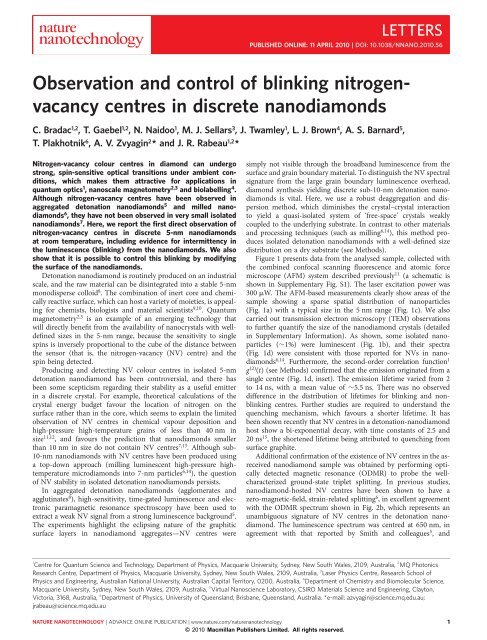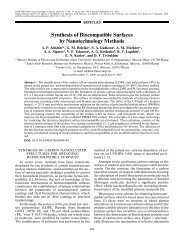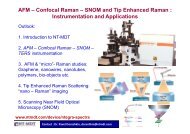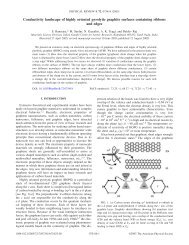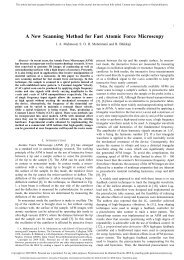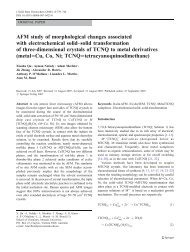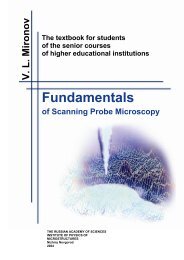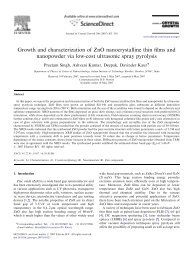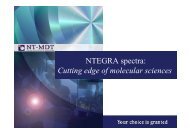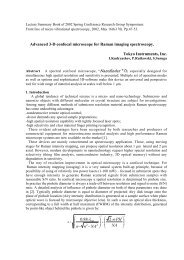Observation and control of blinking nitrogen-vacancy centres in ...
Observation and control of blinking nitrogen-vacancy centres in ...
Observation and control of blinking nitrogen-vacancy centres in ...
You also want an ePaper? Increase the reach of your titles
YUMPU automatically turns print PDFs into web optimized ePapers that Google loves.
LETTERSPUBLISHED ONLINE: 11 APRIL 2010 | DOI: 10.1038/NNANO.2010.56<strong>Observation</strong> <strong>and</strong> <strong>control</strong> <strong>of</strong> <strong>bl<strong>in</strong>k<strong>in</strong>g</strong> <strong>nitrogen</strong><strong>vacancy</strong><strong>centres</strong> <strong>in</strong> discrete nanodiamondsC. Bradac 1,2 ,T.Gaebel 1,2 ,N.Naidoo 1 ,M.J.Sellars 3 ,J.Twamley 1 ,L.J.Brown 4 ,A.S.Barnard 5 ,T. Plakhotnik 6 ,A.V.Zvyag<strong>in</strong> 2 * <strong>and</strong> J. R. Rabeau 1,2 *Nitrogen-<strong>vacancy</strong> colour <strong>centres</strong> <strong>in</strong> diamond can undergostrong, sp<strong>in</strong>-sensitive optical transitions under ambient conditions,which makes them attractive for applications <strong>in</strong>quantum optics 1 , nanoscale magnetometry 2,3 <strong>and</strong> biolabell<strong>in</strong>g 4 .Although <strong>nitrogen</strong>-<strong>vacancy</strong> <strong>centres</strong> have been observed <strong>in</strong>aggregated detonation nanodiamonds 5 <strong>and</strong> milled nanodiamonds6 , they have not been observed <strong>in</strong> very small isolatednanodiamonds 7 . Here, we report the first direct observation <strong>of</strong><strong>nitrogen</strong>-<strong>vacancy</strong> <strong>centres</strong> <strong>in</strong> discrete 5-nm nanodiamondsat room temperature, <strong>in</strong>clud<strong>in</strong>g evidence for <strong>in</strong>termittency <strong>in</strong>the lum<strong>in</strong>escence (<strong>bl<strong>in</strong>k<strong>in</strong>g</strong>) from the nanodiamonds. We alsoshow that it is possible to <strong>control</strong> this <strong>bl<strong>in</strong>k<strong>in</strong>g</strong> by modify<strong>in</strong>gthe surface <strong>of</strong> the nanodiamonds.Detonation nanodiamond is rout<strong>in</strong>ely produced on an <strong>in</strong>dustrialscale, <strong>and</strong> the raw material can be dis<strong>in</strong>tegrated <strong>in</strong>to a stable 5-nmmonodisperse colloid 8 . The comb<strong>in</strong>ation <strong>of</strong> <strong>in</strong>ert core <strong>and</strong> chemicallyreactive surface, which can host a variety <strong>of</strong> moieties, is appeal<strong>in</strong>gfor chemists, biologists <strong>and</strong> material scientists 9,10 . Quantummagnetometry 2,3 is an example <strong>of</strong> an emerg<strong>in</strong>g technology thatwill directly benefit from the availability <strong>of</strong> nanocrystals with welldef<strong>in</strong>edsizes <strong>in</strong> the 5-nm range, because the sensitivity to s<strong>in</strong>glesp<strong>in</strong>s is <strong>in</strong>versely proportional to the cube <strong>of</strong> the distance betweenthe sensor (that is, the <strong>nitrogen</strong>-<strong>vacancy</strong> (NV) centre) <strong>and</strong> thesp<strong>in</strong> be<strong>in</strong>g detected.Produc<strong>in</strong>g <strong>and</strong> detect<strong>in</strong>g NV colour <strong>centres</strong> <strong>in</strong> isolated 5-nmdetonation nanodiamond has been controversial, <strong>and</strong> there hasbeen some scepticism regard<strong>in</strong>g their stability as a useful emitter<strong>in</strong> a discrete crystal. For example, theoretical calculations <strong>of</strong> thecrystal energy budget favour the location <strong>of</strong> <strong>nitrogen</strong> on thesurface rather than <strong>in</strong> the core, which seems to expla<strong>in</strong> the limitedobservation <strong>of</strong> NV <strong>centres</strong> <strong>in</strong> chemical vapour deposition <strong>and</strong>high-pressure high-temperature gra<strong>in</strong>s <strong>of</strong> less than 40 nm <strong>in</strong>size 11,12 , <strong>and</strong> favours the prediction that nanodiamonds smallerthan 10 nm <strong>in</strong> size do not conta<strong>in</strong> NV <strong>centres</strong> 7,13 . Although sub-10-nm nanodiamonds with NV <strong>centres</strong> have been produced us<strong>in</strong>ga top-down approach (mill<strong>in</strong>g lum<strong>in</strong>escent high-pressure hightemperaturemicrodiamonds <strong>in</strong>to 7-nm particles 6,14 ), the question<strong>of</strong> NV stability <strong>in</strong> isolated detonation nanodiamonds persists.In aggregated detonation nanodiamonds (agglomerates <strong>and</strong>agglut<strong>in</strong>ates 8 ), high-sensitivity, time-gated lum<strong>in</strong>escence <strong>and</strong> electronicparamagnetic resonance spectroscopy have been used toextract a weak NV signal from a strong lum<strong>in</strong>escence background 5 .The experiments highlight the eclips<strong>in</strong>g nature <strong>of</strong> the graphiticsurface layers <strong>in</strong> nanodiamond aggregates—NV <strong>centres</strong> weresimply not visible through the broadb<strong>and</strong> lum<strong>in</strong>escence from thesurface <strong>and</strong> gra<strong>in</strong> boundary material. To dist<strong>in</strong>guish the NV spectralsignature from the large gra<strong>in</strong> boundary lum<strong>in</strong>escence overhead,diamond synthesis yield<strong>in</strong>g discrete sub-10-nm detonation nanodiamondsis vital. Here, we use a robust deaggregation <strong>and</strong> dispersionmethod, which dim<strong>in</strong>ishes the crystal–crystal <strong>in</strong>teractionto yield a quasi-isolated system <strong>of</strong> ‘free-space’ crystals weaklycoupled to the underly<strong>in</strong>g substrate. In contrast to other materials<strong>and</strong> process<strong>in</strong>g techniques (such as mill<strong>in</strong>g 6,14 ), this method producesisolated detonation nanodiamonds with a well-def<strong>in</strong>ed sizedistribution on a dry substrate (see Methods).Figure 1 presents data from the analysed sample, collected withthe comb<strong>in</strong>ed confocal scann<strong>in</strong>g fluorescence <strong>and</strong> atomic forcemicroscope (AFM) system described previously 11 (a schematic isshown <strong>in</strong> Supplementary Fig. S1). The laser excitation power was300 mW. The AFM-based measurements clearly show areas <strong>of</strong> thesample show<strong>in</strong>g a sparse spatial distribution <strong>of</strong> nanoparticles(Fig. 1a) with a typical size <strong>in</strong> the 5 nm range (Fig. 1c). We alsocarried out transmission electron microscopy (TEM) observationsto further quantify the size <strong>of</strong> the nanodiamond crystals (detailed<strong>in</strong> Supplementary Information). As shown, some isolated nanoparticles(≏1%) were lum<strong>in</strong>escent (Fig. 1b), <strong>and</strong> their spectra(Fig. 1d) were consistent with those reported for NVs <strong>in</strong> nanodiamonds6,14 . Furthermore, the second-order correlation function 1g (2) (t) (see Methods) confirmed that the emission orig<strong>in</strong>ated from as<strong>in</strong>gle centre (Fig. 1d, <strong>in</strong>set). The emission lifetime varied from 2to 14 ns, with a mean value <strong>of</strong> ≏5.5 ns. There was no observeddifference <strong>in</strong> the distribution <strong>of</strong> lifetimes for <strong>bl<strong>in</strong>k<strong>in</strong>g</strong> <strong>and</strong> non<strong>bl<strong>in</strong>k<strong>in</strong>g</strong><strong>centres</strong>. Further studies are required to underst<strong>and</strong> thequench<strong>in</strong>g mechanism, which favours a shorter lifetime. It hasbeen shown recently that NV <strong>centres</strong> <strong>in</strong> a detonation-nanodiamondhost show a bi-exponential decay, with time constants <strong>of</strong> 2.5 <strong>and</strong>20 ns 15 , the shortened lifetime be<strong>in</strong>g attributed to quench<strong>in</strong>g fromsurface graphite.Additional confirmation <strong>of</strong> the existence <strong>of</strong> NV <strong>centres</strong> <strong>in</strong> the asreceivednanodiamond sample was obta<strong>in</strong>ed by perform<strong>in</strong>g opticallydetected magnetic resonance (ODMR) to probe the wellcharacterizedground-state triplet splitt<strong>in</strong>g. In previous studies,nanodiamond-hosted NV <strong>centres</strong> have been shown to have azero-magnetic-field, stra<strong>in</strong>-related splitt<strong>in</strong>g 6 , <strong>in</strong> excellent agreementwith the ODMR spectrum shown <strong>in</strong> Fig. 2b, which represents anunambiguous signature <strong>of</strong> NV <strong>centres</strong> <strong>in</strong> the detonation nanodiamond.The lum<strong>in</strong>escence spectrum was centred at 650 nm, <strong>in</strong>agreement with that reported by Smith <strong>and</strong> colleagues 5 , <strong>and</strong>1Centre for Quantum Science <strong>and</strong> Technology, Department <strong>of</strong> Physics, Macquarie University, Sydney, New South Wales, 2109, Australia, 2 MQ PhotonicsResearch Centre, Department <strong>of</strong> Physics, Macquarie University, Sydney, New South Wales, 2109, Australia, 3 Laser Physics Centre, Research School <strong>of</strong>Physics <strong>and</strong> Eng<strong>in</strong>eer<strong>in</strong>g, Australian National University, Australian Capital Territory, 0200, Australia, 4 Department <strong>of</strong> Chemistry <strong>and</strong> Biomolecular Science,Macquarie University, Sydney, New South Wales, 2109, Australia, 5 Virtual Nanoscience Laboratory, CSIRO Materials Science <strong>and</strong> Eng<strong>in</strong>eer<strong>in</strong>g, Clayton,Victoria, 3168, Australia, 6 Department <strong>of</strong> Physics, University <strong>of</strong> Queensl<strong>and</strong>, Brisbane, Queensl<strong>and</strong>, Australia. *e-mail: azvyag<strong>in</strong>@science.mq.edu.au;jrabeau@science.mq.edu.auNATURE NANOTECHNOLOGY | ADVANCE ONLINE PUBLICATION | www.nature.com/naturenanotechnology 1© 2010 Macmillan Publishers Limited. All rights reserved.
LETTERSNATURE NANOTECHNOLOGY DOI: 10.1038/NNANO.2010.56ab500 nm500 nmcZ (nm)7d655 nm 34322100 10 20 30 40X (nm)1Intensity (a.u.)g (2) (τ)1.51.00.50.0−75 0 75Delay, τ (s)100 nm0640 720 800 880Wavelength (nm)Figure 1 | Characterization <strong>of</strong> discrete 5-nm diamonds on a glass coverslip. a, AFM image <strong>of</strong> nanodiamonds. The brightness <strong>of</strong> the spots is proportional tothe height <strong>of</strong> the crystals (circles highlight the correspondence between the AFM image <strong>and</strong> the confocal image <strong>of</strong> b). b, Correspond<strong>in</strong>g confocal scann<strong>in</strong>gfluorescence microscopy image. Bright spots <strong>in</strong>dicate NV emitters. c, Magnified AFM image <strong>and</strong> correspond<strong>in</strong>g surface pr<strong>of</strong>ile (<strong>in</strong>set) <strong>of</strong> a representativenanocrystal 5 nm <strong>in</strong> height. d, Emission spectrum <strong>of</strong> an NV centre <strong>in</strong> a 5-nm crystal host <strong>and</strong> correspond<strong>in</strong>g second-order correlation function g (2) (<strong>in</strong>set).a2b 4.6Intensity (a.u.)1(i)(ii)Counts (×10 3 )4.44.24.00600 660 720 780 840Wavelength (nm)3.82,840 2,880 2,920Frequency (MHz)Figure 2 | Lum<strong>in</strong>escence <strong>and</strong> magnetic resonance spectra from detonation nanodiamond. a, Representative NV centre spectra, as acquired <strong>in</strong>nanodiamonds <strong>in</strong>corporated <strong>in</strong> aggregates <strong>and</strong>/or a PVA film (i) <strong>and</strong> <strong>in</strong> the free-space sample (ii). b, Optically detected magnetic resonance spectrumassociated with the lum<strong>in</strong>escence spectrum (i), show<strong>in</strong>g the two characteristic magnetic resonance dips <strong>in</strong>dicat<strong>in</strong>g a stra<strong>in</strong>-<strong>in</strong>duced splitt<strong>in</strong>g <strong>of</strong> the m s ¼+1sp<strong>in</strong> sublevels typical <strong>of</strong> NV <strong>centres</strong> <strong>in</strong> nanodiamonds.probably <strong>in</strong>cluded a strong sp 2 -bonded carbon lum<strong>in</strong>escence fromthe gra<strong>in</strong> boundary <strong>of</strong> the nanodiamond agglomerates, which overshadowedthe NV lum<strong>in</strong>escence (centred at 700 nm, compare withFig. 1d), but not the ODMR signal. ODMR was undetectable withour apparatus <strong>in</strong> the free-space nanodiamonds. We attribute thisto strong dephas<strong>in</strong>g ow<strong>in</strong>g to the distorted crystal order <strong>and</strong> aweak signal exacerbated by the reduced count rate due to <strong>bl<strong>in</strong>k<strong>in</strong>g</strong>.The observation <strong>of</strong> lum<strong>in</strong>escence from s<strong>in</strong>gle, isolated NV<strong>centres</strong> <strong>in</strong> 5-nm detonation nanodiamonds, which has been thesubject <strong>of</strong> <strong>in</strong>tense debate, is important because, until now, lum<strong>in</strong>escencefrom ≏5-nm crystals has been observed only <strong>in</strong> detonationnanodiamond agglomerates 5 . Furthermore, <strong>and</strong> <strong>in</strong> contrast toagglomerates (where the diamond surface is largely encased), wealso observed a new property <strong>of</strong> NV <strong>centres</strong>: lum<strong>in</strong>escence <strong>in</strong>termittencyor ‘<strong>bl<strong>in</strong>k<strong>in</strong>g</strong>’. NV has been described as an extremely photostableemitter immune to bleach<strong>in</strong>g 1 or <strong>bl<strong>in</strong>k<strong>in</strong>g</strong>, as representedby a typical lum<strong>in</strong>escence time trajectory (Fig. 3a) acquired <strong>in</strong> asample prepared us<strong>in</strong>g the polyv<strong>in</strong>yl alcohol (PVA) polymersample preparation method 6 .Figure 3c shows a representative <strong>bl<strong>in</strong>k<strong>in</strong>g</strong> lum<strong>in</strong>escence time trajectoryfrom a nanodiamond conta<strong>in</strong><strong>in</strong>g an NV centre, <strong>in</strong> which thediamonds were prepared as described <strong>in</strong> the Methods. Bl<strong>in</strong>k<strong>in</strong>g was2NATURE NANOTECHNOLOGY | ADVANCE ONLINE PUBLICATION | www.nature.com/naturenanotechnology© 2010 Macmillan Publishers Limited. All rights reserved.
NATURE NANOTECHNOLOGY DOI: 10.1038/NNANO.2010.56LETTERSabPhotocounts per4-ms b<strong>in</strong>400200Photocounts per4-ms b<strong>in</strong>4002000 1 2 0 400 800Time (s)OccurrencecdPhotocounts per4-ms b<strong>in</strong>400200Photocounts per4-ms b<strong>in</strong>400200eOccurrence01 2 0 400 80010 0 10 0Time (s)Occurrence10 3 f 10 39020601710 210 214300.4 0.6 0.80.4 0.6 0.8Laser <strong>in</strong>tensityLaser <strong>in</strong>tensity10 1(MW cm −2 )10 1(MW cm −2 )τ on (ms)Occurrenceτ <strong>of</strong>f (ms)0 75 150 225 300075150‘On’ time <strong>in</strong>terval (ms)‘Off’ time <strong>in</strong>terval (ms)Figure 3 | Detailed analysis <strong>of</strong> <strong>bl<strong>in</strong>k<strong>in</strong>g</strong> statistics from an NV centre <strong>in</strong> detonation nanodiamond. a–d, A 2-s fragment <strong>of</strong> a 200-s lum<strong>in</strong>escence timetrajectory <strong>of</strong> the NV <strong>centres</strong> sampled <strong>in</strong>to 4-ms b<strong>in</strong>s from two separate diamond samples: NV lum<strong>in</strong>escence from nanodiamonds embedded <strong>in</strong> a PVApolymer film (a), with correspond<strong>in</strong>g histogram fitted with a s<strong>in</strong>gle Gaussian (b), where the l<strong>in</strong>e <strong>in</strong> a is the mean count rate; a s<strong>in</strong>gle isolated NV <strong>in</strong>nanodiamond display<strong>in</strong>g <strong>in</strong>termittent lum<strong>in</strong>escence (c), with correspond<strong>in</strong>g histogram <strong>of</strong> the full time trajectory fitted with two Gaussians (d). Gaussians arefitted to the ‘on’ <strong>and</strong> ‘<strong>of</strong>f’ state photon distributions <strong>and</strong> a l<strong>in</strong>e is drawn through c to <strong>in</strong>dicate the on/<strong>of</strong>f ‘threshold’ for analys<strong>in</strong>g the emission statistics.e,f, Bl<strong>in</strong>k<strong>in</strong>g statistics <strong>of</strong> the ‘on’ <strong>and</strong> ‘<strong>of</strong>f’ states on a semi-logarithmic scale (symbols). A s<strong>in</strong>gle exponential is fitted <strong>in</strong> both cases, with time constants 45<strong>and</strong> 18 ms, respectively. Insets to e <strong>and</strong> f plot <strong>bl<strong>in</strong>k<strong>in</strong>g</strong> time constant versus the excitation laser <strong>in</strong>tensities for ‘on’ <strong>and</strong> ‘<strong>of</strong>f’ states, respectively.observed <strong>in</strong> ≏25% <strong>of</strong> the lum<strong>in</strong>escent sites. The ‘<strong>of</strong>f’ state was at thelevel <strong>of</strong> the background signal, <strong>and</strong> <strong>bl<strong>in</strong>k<strong>in</strong>g</strong> due to photochromism16 was ruled out as the neutral NV lum<strong>in</strong>escence signaturewas never observed <strong>in</strong> the spectra. Photobleach<strong>in</strong>g was also observedon some <strong>of</strong> the <strong>centres</strong>; however, those analysed <strong>in</strong> this Lettershowed lum<strong>in</strong>escence over several hours <strong>of</strong> illum<strong>in</strong>ation. We analysed<strong>bl<strong>in</strong>k<strong>in</strong>g</strong> by sampl<strong>in</strong>g the lum<strong>in</strong>escence time trajectories at4-ms time b<strong>in</strong>s <strong>and</strong> analysed the data us<strong>in</strong>g accepted signal-process<strong>in</strong>galgorithms, <strong>in</strong> which the position <strong>of</strong> the signal relative to athreshold level determ<strong>in</strong>es the assignment <strong>of</strong> the states 17 . The <strong>bl<strong>in</strong>k<strong>in</strong>g</strong>phenomena were also characterized as a function <strong>of</strong> the excitation<strong>in</strong>tensity (shown <strong>in</strong> the <strong>in</strong>sets <strong>of</strong> Fig. 3e,f, <strong>and</strong> detailed <strong>in</strong>the Supplementary Information).The 4-ms b<strong>in</strong> width was chosen because it provides the deepestm<strong>in</strong>imum between the two Gaussian curves shown <strong>in</strong> Fig. 3d.Averag<strong>in</strong>g data <strong>in</strong>to 4-ms b<strong>in</strong>s on the one h<strong>and</strong> ignores the rapidevents that may display complex dynamics 18 , but on the otherh<strong>and</strong> decreases the noise <strong>and</strong> emphasizes the two-state NV-nanodiamond<strong>bl<strong>in</strong>k<strong>in</strong>g</strong> system, as shown <strong>in</strong> Fig. 3d. Chang<strong>in</strong>g the b<strong>in</strong>time to 2 ms did not change the result, <strong>and</strong> with 1-ms b<strong>in</strong>s thestatistical noise was too pronounced for a mean<strong>in</strong>gful result.These two states are identified as ‘on’ <strong>and</strong> ‘<strong>of</strong>f’ 19 . Quantum dots 20 ,s<strong>in</strong>gle molecules 21 , silicon nanocrystals <strong>in</strong> a porous siliconmatrix 22 <strong>and</strong> others 23 are well-known systems that show <strong>bl<strong>in</strong>k<strong>in</strong>g</strong>.The validity <strong>of</strong> the two-state on/<strong>of</strong>f model is <strong>in</strong>tensely debated 24 ,especially <strong>in</strong> the context <strong>of</strong> quantum-dot studies, where, forexample, three states 25 <strong>and</strong> a cont<strong>in</strong>uous distribution <strong>of</strong> states 26have been reported. In our case, the validity <strong>of</strong> the two-statemodel was underp<strong>in</strong>ned by the photon distribution <strong>in</strong> ‘on’ <strong>and</strong>‘<strong>of</strong>f’ states based on the Gaussian distribution <strong>and</strong> expressed as⎡ ( ) 2⎤PN ( ) = p N − ¯N onon√⎢⎥exp⎣−⎦2p son2s 2 on⎡ ( ) 2⎤+ p N − ¯N <strong>of</strong>f<strong>of</strong>f√⎢⎥exp⎣−⎦2p s<strong>of</strong>f2s 2 <strong>of</strong>fwhere ¯N represents the mean value <strong>of</strong> the number <strong>of</strong> photons <strong>in</strong>each state, p is the population <strong>of</strong> the states, N the total number <strong>of</strong>photons <strong>and</strong> s 2 the variance <strong>of</strong> the distribution. For a stablephoton emission, the variance equals the mean value. The fit tothe distribution reveals s 2 on to be only about two times largerthan the mean ¯N on . This determ<strong>in</strong>ed our choice <strong>of</strong> the thresholdlevel between the ‘on’ <strong>and</strong> ‘<strong>of</strong>f’ states, which was set at the <strong>in</strong>tersection<strong>of</strong> the two Gaussians (Fig. 3c,d), where the probabilities for N tobe at the ‘on’ <strong>and</strong> ‘<strong>of</strong>f’ levels were equal. The distribution <strong>of</strong> the ‘on’<strong>and</strong> ‘<strong>of</strong>f’ times are plotted on a semi-logarithmic scale <strong>in</strong> Fig. 3e,f,NATURE NANOTECHNOLOGY | ADVANCE ONLINE PUBLICATION | www.nature.com/naturenanotechnology 3© 2010 Macmillan Publishers Limited. All rights reserved.
LETTERSNATURE NANOTECHNOLOGY DOI: 10.1038/NNANO.2010.56a b 0.05cR Bohr R Bohr0.3R Bohr R Bohr0.040.2Structural disorder, Δd (Å)0.030.020.010.00−0.01−0.02−0.03−0.04Electronic disorder, ΔE LUMO (eV)0.10.0−0.1−0.2−0.3−0.4−0.5−0.05−1.0 −0.8−0.6−0.4−0.2 0.0 0.2 0.4 0.6 0.8 1.0Distance from centre, r/R−0.6−1.0 −0.8−0.6−0.4−0.2 0.0 0.2 0.4 0.6 0.8 1.0Distance from centre, r/RFigure 4 | Theoretical characterization <strong>of</strong> the structural <strong>and</strong> electronic disorder. a, Nanodiamond model, with all NV sites shown simultaneously (blue).b, Site-dependent change <strong>in</strong> the average C–N bond length (Dd). c, Site-dependent change <strong>in</strong> the energy <strong>of</strong> the lowest unoccupied molecular orbital(DE LUMO ). Closed symbols denote NV <strong>centres</strong> located with<strong>in</strong> a Bohr excitonic radius from surfaces/edges/corners (where the surface/edge/corner is at 1 or21 with respect to the centrosymmetric atom at the orig<strong>in</strong>), where atoms with mixed hybridization reside, <strong>and</strong> open symbols <strong>in</strong>dicate NV <strong>centres</strong> locatedbeyond the excitonic radius from surfaces/edges/corners (that is, with<strong>in</strong> the core, where atoms are entirely sp 3 -hybridized).together with the data-fitt<strong>in</strong>g curves, which display exponentialtrends <strong>in</strong> both the ‘on’ <strong>and</strong> ‘<strong>of</strong>f’ cases.We now discuss <strong>bl<strong>in</strong>k<strong>in</strong>g</strong> mechanisms <strong>in</strong> the context <strong>of</strong> otherwell-studied systems. Passivated quantum dots <strong>and</strong> s<strong>in</strong>gle molecules<strong>in</strong> polymer matrices are examples <strong>of</strong> trap-abundant quantumsystems that show <strong>bl<strong>in</strong>k<strong>in</strong>g</strong>. It has been shown that remov<strong>in</strong>gtraps from the passivated quantum-dot surface suppresses <strong>bl<strong>in</strong>k<strong>in</strong>g</strong>23 . In general, excitation/emission is mediated by an exciton,(that is, charge separation, where the electron determ<strong>in</strong>es thek<strong>in</strong>etics <strong>of</strong> this process by virtue <strong>of</strong> its higher mobility). It is thecapture <strong>of</strong> this electron by (surface) traps that <strong>in</strong>hibits excitonrecomb<strong>in</strong>ation (switch<strong>in</strong>g the emitter to the ‘<strong>of</strong>f’ state) where thetrap-abundant matrix disorder promotes this capture 23 . Theoptical excitation/emission process <strong>in</strong> an NV centre is also mediatedby an exciton. However, the NV defect-associated exciton is bound,or localized at the NV site, with<strong>in</strong> the Bohr radius (,1 nm), unlikethe case for quantum dots, where an exciton is essentially delocalized.In the case <strong>of</strong> NVs <strong>in</strong> ≏5-nm detonation nanodiamonds,the <strong>bl<strong>in</strong>k<strong>in</strong>g</strong> may therefore be a manifestation <strong>of</strong> the local crystaldisorder. An NV centre is situated <strong>in</strong> a ≏5-nm crystal compris<strong>in</strong>ga crystall<strong>in</strong>e diamond core sized 2–3 nm <strong>and</strong> a mixed sp 2 –sp 3hybridization shell <strong>of</strong> quasi-spherical shape 27 distorted by thelarge proportion <strong>of</strong> surface dangl<strong>in</strong>g bonds (≏20% <strong>of</strong> total carbonatoms) 28 , dislocations 29 <strong>and</strong> impurities. The outer shell has beenfound to rega<strong>in</strong> some sp 3 hybridization by surface passivation, forexample, with oxygen-conta<strong>in</strong><strong>in</strong>g moieties 28,30 , as <strong>in</strong> the presentstudy. Ow<strong>in</strong>g to the proximity <strong>of</strong> the NV centre to the nanodiamondsurface, it is also a possibility that surface functional groups <strong>and</strong>/oradsorbed species may also be a source <strong>of</strong> traps caus<strong>in</strong>g <strong>bl<strong>in</strong>k<strong>in</strong>g</strong>.To assess the degree <strong>of</strong> disorder <strong>in</strong> a typical nanodiamond, wecarried out a series <strong>of</strong> density functional tight b<strong>in</strong>d<strong>in</strong>g (DFTB) simulationson a model truncated octahedral structure, with all surfacesfully passivated with hydrogen atoms (C 837 H 252 ). NV defects were<strong>in</strong>dividually <strong>in</strong>serted <strong>in</strong>to over 50 unique lattice sites with<strong>in</strong> the particle,as shown <strong>in</strong> Fig. 4a <strong>and</strong> described <strong>in</strong> the SupplementaryInformation. A number <strong>of</strong> parameters were used to assess the localcrystal disorder at these sites, <strong>in</strong>clud<strong>in</strong>g the change <strong>in</strong> the averageC–N bond length (Dd), as shown <strong>in</strong> Fig. 4b. When sufficient disorderis present, there will be a shift <strong>in</strong> the electronic states, so the change <strong>in</strong>the energy <strong>of</strong> the lowest unoccupied molecular orbital (DE LUMO )wasalso considered, as shown <strong>in</strong> Fig. 4c. In these <strong>and</strong> other cases (seeSupplementary Information), the disorder is extreme when the siteis with<strong>in</strong> the excitonic radius (R Bohr ) from the surfaces, edges <strong>and</strong>corners (closed symbols), <strong>and</strong> NV <strong>centres</strong> with<strong>in</strong> the core <strong>of</strong> theparticle (where disorder is absent or <strong>in</strong>significant) are the only<strong>centres</strong> that are likely to be optically active (open symbols <strong>in</strong> Fig.4b,c). More details on the theoretical modell<strong>in</strong>g are available <strong>in</strong> theSupplementary Information.It is important to note that when these 5-nm diamonds werecomb<strong>in</strong>ed <strong>in</strong>to aggregates <strong>and</strong>/or embedded <strong>in</strong> a polymer PVAfilm, electronic discont<strong>in</strong>uity at the <strong>in</strong>terface was altered, <strong>and</strong> the<strong>in</strong>dividual NV-centre lum<strong>in</strong>escence temporal behaviour wasrestored to a cont<strong>in</strong>uous lum<strong>in</strong>escence signal, with no exceptions(Fig. 3a). This result reproduced previous reports on NV lum<strong>in</strong>escence<strong>in</strong> nanodiamonds 4,5,12,14 . However, <strong>in</strong> free space, discrete5-nm nanodiamonds conta<strong>in</strong><strong>in</strong>g an NV centre revealed a new lum<strong>in</strong>escence<strong>in</strong>termittency pattern, for which the effect <strong>of</strong> the nanodiamondsurface state (as <strong>in</strong> the aggregated or polymer-embeddedstate) warrants further study.This <strong>in</strong>sight <strong>in</strong>to the properties <strong>of</strong> NV <strong>centres</strong> <strong>in</strong> discrete nanodiamonds,as reported here, may affect a range <strong>of</strong> applications <strong>in</strong> thephysical <strong>and</strong> life sciences. The presence or absence <strong>of</strong> <strong>bl<strong>in</strong>k<strong>in</strong>g</strong> <strong>in</strong>nanodiamonds provides <strong>in</strong>formation about the local <strong>and</strong> surround<strong>in</strong>genvironment <strong>of</strong> the hosted NV centre, which could f<strong>in</strong>d use <strong>in</strong> avariety <strong>of</strong> quantum or biosens<strong>in</strong>g technologies. For example, harness<strong>in</strong>gthe environmental sensitivity <strong>of</strong> <strong>bl<strong>in</strong>k<strong>in</strong>g</strong> may enable theoptical detection <strong>of</strong> changes <strong>in</strong> the surface functionalization <strong>of</strong> ananodiamond probe.MethodsDetonation diamond nanocrystals (as received, Diamond Technologies <strong>and</strong>Materials) with an average size <strong>of</strong> 5 nm, as measured by dynamic light scatter<strong>in</strong>g(not shown), were used for the experiments. The diamonds were processed us<strong>in</strong>gstrong acid reflux <strong>and</strong> ultrasonication 31,32 , as outl<strong>in</strong>ed below.The preparation <strong>of</strong> the nanodiamonds <strong>in</strong>cluded a number <strong>of</strong> previously reportedmethods 31,32 , <strong>and</strong> was modified for optimal deagglomeration. It is worth mention<strong>in</strong>gthat thermal oxidation can yield disperse sub-10-nm nanodiamond crystals on laceycarbon, as reported previously 28 . Nanodiamonds were mixed with sulphuric acid(98%, 9 ml) <strong>and</strong> nitric acid (70%, 1 ml) <strong>and</strong> then refluxed for 3 days at 70 8C. Themixture was centrifuged <strong>and</strong> ultrasonicated, then refluxed aga<strong>in</strong> with a fresh acidmixture. Nanodiamonds were washed with Milli-Q w then refluxed with NaOH(0.1 M, 8 ml; 1 h, 90 8C), washed, then refluxed with HCl (0.1 M, 8 ml). Thenanodiamond–acid mixture was washed with Milli-Q w <strong>and</strong> ultrasonicated (1 h).The sample was diluted by addition <strong>of</strong> Milli-Q (≏20 ml) <strong>and</strong> ultracentrifuged (1 h,100,000g). This procedure was repeated three times, <strong>and</strong> the result<strong>in</strong>g supernatantconta<strong>in</strong><strong>in</strong>g <strong>in</strong>dividual diamond gra<strong>in</strong>s was used for these experiments.Nanodiamonds were either dropped onto a glass coverslip <strong>and</strong> left to dry, or sp<strong>in</strong>coated.The compositions <strong>of</strong> the treated <strong>and</strong> untreated diamond were assessed byRaman spectroscopy (see Supplementary Information), show<strong>in</strong>g a dramatic decrease<strong>in</strong> the graphitic compared with diamond content <strong>of</strong> the sample.To embed nanodiamonds <strong>in</strong> a PVA film, they were mixed, <strong>in</strong> differentproportions, with a 0.25% solution <strong>of</strong> PVA <strong>in</strong> de-ionized water. Two different4NATURE NANOTECHNOLOGY | ADVANCE ONLINE PUBLICATION | www.nature.com/naturenanotechnology© 2010 Macmillan Publishers Limited. All rights reserved.
NATURE NANOTECHNOLOGY DOI: 10.1038/NNANO.2010.56LETTERSmolecular weight PVAs were used: average M w , 85,000–24,000 (Aldrich 363146);average M w , 31,000–50,000 (Aldrich 363138).The agglomerated nanodiamonds were measured us<strong>in</strong>g optical microscopy <strong>and</strong>AFM-zoom<strong>in</strong>g on the regions <strong>of</strong> clear aggregation. Simultaneous topographic <strong>and</strong>lum<strong>in</strong>escence imag<strong>in</strong>g <strong>of</strong> the same sample area was carried out us<strong>in</strong>g a ‘home-built’,room-temperature confocal scann<strong>in</strong>g fluorescence microscope (×100 oil-immersionobjective lens, NA 1.4) illum<strong>in</strong>ated with a cont<strong>in</strong>uous-wave 532-nm diode-pumpedsolid-state laser (Coherent, model: Compass 315M-100), comb<strong>in</strong>ed with acommercial AFM (NT-MDT Ntegra) as described elsewhere 11 . The lum<strong>in</strong>escencespectrum was acquired us<strong>in</strong>g a spectrometer (Pr<strong>in</strong>ceton Instruments Acton 2500i,Camera Pixis 100 model: 7515-0001). A Hanbury Brown <strong>and</strong> Twiss <strong>in</strong>terferometerwas used to measure the second-order correlation function g (2) (t) ¼ ,I(t)I(t þ t)/I(t) 2 . , where I is the lum<strong>in</strong>escence signal <strong>in</strong>tensity. The number <strong>of</strong> emittersper <strong>in</strong>dividual illum<strong>in</strong>ated nanocrystal was determ<strong>in</strong>ed by analys<strong>in</strong>g g (2) at t ¼ 0 <strong>and</strong>t ¼ 1, where g (2) (t ¼ 0) is the probability <strong>of</strong> detect<strong>in</strong>g two simultaneous photonsnormalized by the probability <strong>of</strong> detect<strong>in</strong>g two photons at once for a r<strong>and</strong>om photonsource. Because a s<strong>in</strong>gle quantum system, such as a s<strong>in</strong>gle NV centre, cannotsimultaneously emit two photons at a time, g (2) (t ¼ 0) ¼ 0, yield<strong>in</strong>g an‘antibunch<strong>in</strong>g’ dip otherwise governed by the sub-Poissonian statistics <strong>of</strong> the emittedphotons. The g (2) -contrast reports on the number <strong>of</strong> sampled emitters N e , because itscales as 1/ N e (ref. 1).ODMR <strong>in</strong>terrogation <strong>of</strong> the s<strong>in</strong>gle NV <strong>centres</strong> was designed <strong>and</strong> carried outus<strong>in</strong>g the accepted quantum-mechanical representation <strong>of</strong> an NV centre. The centrerepresents a two-level quantum system, which can be pumped to the first allowedenergy level (excited state) by 532-nm laser excitation. The NV triplet ground energylevels with magnetic quantum numbers m s ¼ 0 <strong>and</strong> m s ¼+1 are split by sp<strong>in</strong>–sp<strong>in</strong><strong>in</strong>teraction by ≏2.88 GHz. The cyclic lum<strong>in</strong>escence <strong>of</strong> the m s ¼+1 excited state is 30%less efficient than that <strong>of</strong> the m s ¼ 0 excited state. The optical pump<strong>in</strong>g populates them s ¼ 0 ground state, thereby sp<strong>in</strong>-polariz<strong>in</strong>g the NV centre. Microwave radiation(2.88 GHz) mixes two ground states, thus caus<strong>in</strong>g a decrease <strong>in</strong> the lum<strong>in</strong>escencesignal, which represents an unambiguous f<strong>in</strong>gerpr<strong>in</strong>t for the NV centre 33 .Themicrowave probe signal (0.2–0.6 mW) from a signal generator (Rohde & SchwarzSMIQ 06B, 300 kHz to 6.4 GHz) was radiated through a 20-mm copper wire situatedon the sample substrate <strong>in</strong> sub-millimetre proximity to the probed NV centre. Theobserved ODMR spectrum featured two peaks, <strong>in</strong>dicat<strong>in</strong>g lift<strong>in</strong>g <strong>of</strong> the m s ¼+1degeneracy, which was recognized to be stra<strong>in</strong>-<strong>in</strong>duced <strong>in</strong> nanodiamonds 6 .Theoretical simulations were performed us<strong>in</strong>g the density-functional-basedtight-b<strong>in</strong>d<strong>in</strong>g method with self-consistent charges (SCC-DFTB) 34 , which is a twocentreapproach to density functional theory, where the Kohn–Sham densityfunctional is exp<strong>and</strong>ed to second order around a reference electron density. Thereference density was obta<strong>in</strong>ed from self-consistent density functional calculations<strong>of</strong> weakly conf<strong>in</strong>ed neutral atoms, <strong>and</strong> the conf<strong>in</strong>ement potential was optimized toanticipate the charge density <strong>and</strong> effective potential <strong>in</strong> molecules <strong>and</strong> solids. Thismethod has the advantage <strong>of</strong> be<strong>in</strong>g non-periodic, <strong>and</strong> has previously been shown tobe suitable for study<strong>in</strong>g the crystall<strong>in</strong>ity <strong>of</strong> diamond nanoparticles 35 <strong>and</strong> thedistribution <strong>of</strong> substitutional <strong>nitrogen</strong> 7 . In the present study, all test structures werefully relaxed us<strong>in</strong>g the conjugate gradient scheme to m<strong>in</strong>imize the total energy. Theconvergence criterion for a stationary po<strong>in</strong>t was 10 24 a.u. ≈5 meV Å 21 for forces.Received 15 January 2010; accepted 1 March 2010;published onl<strong>in</strong>e 11 April 2010References1. Kurtsiefer, C., Mayer, S., Zarda, P. & We<strong>in</strong>furter, H. Stable solid-state source <strong>of</strong>s<strong>in</strong>gle photons. Phys. Rev. Lett. 85, 290–293 (2000).2. Balasubramanian, G. et al. Nanoscale imag<strong>in</strong>g magnetometry with diamondsp<strong>in</strong>s under ambient conditions. Nature 455, 648–651 (2008).3. Maze, J. R. et al. Nanoscale magnetic sens<strong>in</strong>g with an <strong>in</strong>dividual electronic sp<strong>in</strong><strong>in</strong> diamond. Nature 455, 644–647 (2008).4. Chang, Y.-R. et al. Mass production <strong>and</strong> dynamic imag<strong>in</strong>g <strong>of</strong> fluorescentnanodiamonds. Nature Nanotech. 3, 284–288 (2008).5. Smith, B. R. et al. Five-nanometer diamond with lum<strong>in</strong>escent <strong>nitrogen</strong>-<strong>vacancy</strong>defect centers. Small 5, 1649–1653 (2009).6. Tisler, J. et al. Fluorescence <strong>and</strong> sp<strong>in</strong> properties <strong>of</strong> defects <strong>in</strong> s<strong>in</strong>gle digitnanodiamonds. ACS Nano 3, 1959–1965 (2009).7. Barnard, A. S. & Sternberg, M. Substitutional <strong>nitrogen</strong> <strong>in</strong> nanodiamond <strong>and</strong>bucky-diamond particles. J. Phys. Chem. B 109, 17107–17112 (2005).8. Kruger, A. et al. Unusually tight aggregation <strong>in</strong> detonation nanodiamond:identification <strong>and</strong> dis<strong>in</strong>tegration. Carbon 43, 1722–1730 (2005).9. Mochal<strong>in</strong>, V. N. & Gogotsi, Y. Wet chemistry route to hydrophobic bluefluorescent nanodiamond. J. Am. Chem. Soc. 131, 4594–4595 (2009).10. Holt, K. B. Diamond at the nanoscale: applications <strong>of</strong> diamond nanoparticlesfrom cellular biomarkers to quantum comput<strong>in</strong>g. Phil. Trans. R. Soc. A 365,2845–2861 (2007).11. Bradac, C., Gaebel, T., Naidoo, N., Rabeau, J. R. & Barnard, A. S. Prediction <strong>and</strong>measurement <strong>of</strong> the size-dependent stability <strong>of</strong> fluorescence <strong>in</strong> diamond over theentire nanoscale. Nano Lett. 9, 3555–3564 (2009).12. Rabeau, J. R. et al. S<strong>in</strong>gle <strong>nitrogen</strong> <strong>vacancy</strong> centers <strong>in</strong> chemical vapor depositeddiamond nanocrystals. Nano Lett. 7, 3433–3437 (2007).13. Vlasov, I. et al. Nitrogen <strong>and</strong> lum<strong>in</strong>secent <strong>nitrogen</strong>-<strong>vacancy</strong> defects <strong>in</strong>detonation nanodiamond. Small 6, 687–694 (2010).14. Boudou, J. P. et al. High yield fabrication <strong>of</strong> fluorescent nanodiamonds.Nanotechnology 20, 235602 (2009).15. Smith, B. R., Gruber, D. & Plakhotnik, T. The effects <strong>of</strong> surface oxidation onlum<strong>in</strong>escence <strong>of</strong> nano diamonds. Diamond Relat. Mater. 19, 314–318 (2010).16. Gaebel, T. et al. Photochromism <strong>in</strong> s<strong>in</strong>gle <strong>nitrogen</strong>-<strong>vacancy</strong> defect <strong>in</strong> diamond.Appl. Phys. B 82, 243–246 (2006).17. Kuno, M., Fromm, D. P., Hamann, H. F., Gallagher, A. & Nesbitt, D. J. ‘On’/‘<strong>of</strong>f’fluorescence <strong>in</strong>termittency <strong>of</strong> s<strong>in</strong>gle semiconductor quantum dots. J. Chem.Phys. 115, 1028–1040 (2001).18. Tang, J. & Marcus, R. A. Diffusion-<strong>control</strong>led electron transfer processes <strong>and</strong>power-law statistics <strong>of</strong> fluorescence <strong>in</strong>termittency <strong>of</strong> nanoparticles. Phys. Rev.Lett. 95, 107401 (2005).19. Stefani, F. D., Hoogenboom, J. P. & Barkai, E. Beyond quantum jumps: <strong>bl<strong>in</strong>k<strong>in</strong>g</strong>nanoscale light emitters. Phys. Today 34–39 (February 2009).20. Nirmal, M. et al. Fluorescence <strong>in</strong>termittency <strong>in</strong> s<strong>in</strong>gle cadmium selenidenanocrystals. Nature 383, 802–804 (1996).21. Hoogenboom, J. P., van Dijk, E., Hern<strong>and</strong>o, J., van Hulst, N. F. & Garcia-Parajo, M. F. Power-law-distributed dark states are the ma<strong>in</strong> pathway forphotobleach<strong>in</strong>g <strong>of</strong> s<strong>in</strong>gle organic molecules. Phys. Rev. Lett. 95, 097401 (2005).22. Mason, M. D., Credo, G. M., Weston, K. D. & Buratto, S. K. Lum<strong>in</strong>escence <strong>of</strong><strong>in</strong>dividual porous Si chromophores. Phys. Rev. Lett. 80, 5405–5408 (1998).23. Cichos, F., von Borczyskowski, C. & Orrit, M. Power-law <strong>in</strong>termittency <strong>of</strong> s<strong>in</strong>gleemitters. Curr. Op<strong>in</strong>. Colloid Interface Sci. 12, 272–284 (2007).24. Frantsuzov, P., Kuno, M., Janko, B. & Marcus, R. A. Universal emission<strong>in</strong>termittency <strong>in</strong> quantum dots, nanorods <strong>and</strong> nanowires. Nature Phys. 4,519–522 (2008).25. Gomez, D. E., van Embden, J., Mulvaney, P., Fernee, M. J. & Rub<strong>in</strong>szte<strong>in</strong>-Dunlop, H. Exciton–trion transitions <strong>in</strong> s<strong>in</strong>gle CdSe–CdS core–shellnanocrystals. ACS Nano 3, 2281–2287 (2009).26. Zhang, K., Chang, H. Y., Fu, A. H., Alivisatos, A. P. & Yang, H. Cont<strong>in</strong>uousdistribution <strong>of</strong> emission states from s<strong>in</strong>gle CdSe/ZnS quantum dots. Nano Lett.6, 843–847 (2006).27. Palosz, B. et al. Investigation <strong>of</strong> relaxation <strong>of</strong> nanodiamond surface <strong>in</strong> real <strong>and</strong>reciprocal spaces. Diamond Relat. Mater. 15, 1813–1817 (2006).28. Osswald, S., Yush<strong>in</strong>, G., Mochal<strong>in</strong>, V., Kucheyev, S. O. & Gogotsi, Y. Control <strong>of</strong>sp (2) /sp (3) carbon ratio <strong>and</strong> surface chemistry <strong>of</strong> nanodiamond powders byselective oxidation <strong>in</strong> air. J. Am. Chem. Soc. 128, 11635–11642 (2006).29. Iakoubovskii, K. et al. Structure <strong>and</strong> defects <strong>of</strong> detonation synthesisnanodiamond. Diamond Relat. Mater. 9, 861–865 (2000).30. Russo, S. P., Barnard, A. S. & Snook, I. K. Hydrogenation <strong>of</strong> nanodiamondsurfaces: structure <strong>and</strong> effects on crystall<strong>in</strong>e stability. Surf. Rev. Lett. 10,233–239 (2003).31. Morita, Y. et al. A facile <strong>and</strong> scalable process for size-<strong>control</strong>lable separation <strong>of</strong>nanodiamond particles as small as 4 nm. Small 4, 2154–2157 (2008).32. Ushizawa, K. et al. Covalent immobilization <strong>of</strong> DNA on diamond <strong>and</strong> itsverification by diffuse reflectance <strong>in</strong>frared spectroscopy. Chem. Phys. Lett. 351,105–108 (2002).33. Gruber, A. et al. Scann<strong>in</strong>g confocal optical microscopy <strong>and</strong> magnetic resonanceon s<strong>in</strong>gle defect centers. Science 276, 2012–2014 (1997).34. Porezag, D., Frauenheim, T., Kohler, T., Seifert, G. & Kaschner, R. Construction<strong>of</strong> tight-b<strong>in</strong>d<strong>in</strong>g-like potentials on the basis <strong>of</strong> density-functional theory—application to carbon. Phys. Rev. B 51, 12947–12957 (1995).35. Barnard, A. S. & Sternberg, M. Crystall<strong>in</strong>ity <strong>and</strong> surface electrostatics <strong>of</strong>diamond nanocrystals. J. Mater. Chem. 17, 4811–4819 (2007).AcknowledgementsThe authors would like to thank N. Manson <strong>and</strong> F. Treussart for useful discussions, D. Birchfor TEM measurements <strong>and</strong> E. Carter for Raman spectroscopy measurements. T.G. isfunded by a Macquarie University Research Fellowship, C.B. is funded by a MacquarieUniversity Research Excellence Scholarship, <strong>and</strong> J.R.R is funded by an ARC FutureFellowship. The work was funded <strong>in</strong> part by the Australian Research Council (DP0772286<strong>and</strong> DP0771676).Author contributionsC.B., T.G., A.V.Z. <strong>and</strong> J.R.R. conceived <strong>and</strong> designed the experiments, analysed the data,contributed materials/analysis tools <strong>and</strong> co-wrote the paper. T.P. analysed the data <strong>and</strong>contributed analysis tools. M.J.S. contributed ESR equipment <strong>and</strong> expertise. A.S.B. carriedout DFTB simulations <strong>and</strong> analysed simulation data. N.N., J.T., L.B. <strong>and</strong> J.R.R. designed thedeaggregation protocol. N.N. prepared the nanodiamond samples. All authors discussedthe results <strong>and</strong> commented on the manuscript.Additional <strong>in</strong>formationThe authors declare no compet<strong>in</strong>g f<strong>in</strong>ancial <strong>in</strong>terests. Supplementary <strong>in</strong>formationaccompanies this paper at www.nature.com/naturenanotechnology. Repr<strong>in</strong>ts <strong>and</strong>permission <strong>in</strong>formation is available onl<strong>in</strong>e at http://npg.nature.com/repr<strong>in</strong>ts<strong>and</strong>permissions/.Correspondence <strong>and</strong> requests for materials should be addressed to A.V.Z. or J.R.R.NATURE NANOTECHNOLOGY | ADVANCE ONLINE PUBLICATION | www.nature.com/naturenanotechnology 5© 2010 Macmillan Publishers Limited. All rights reserved.


